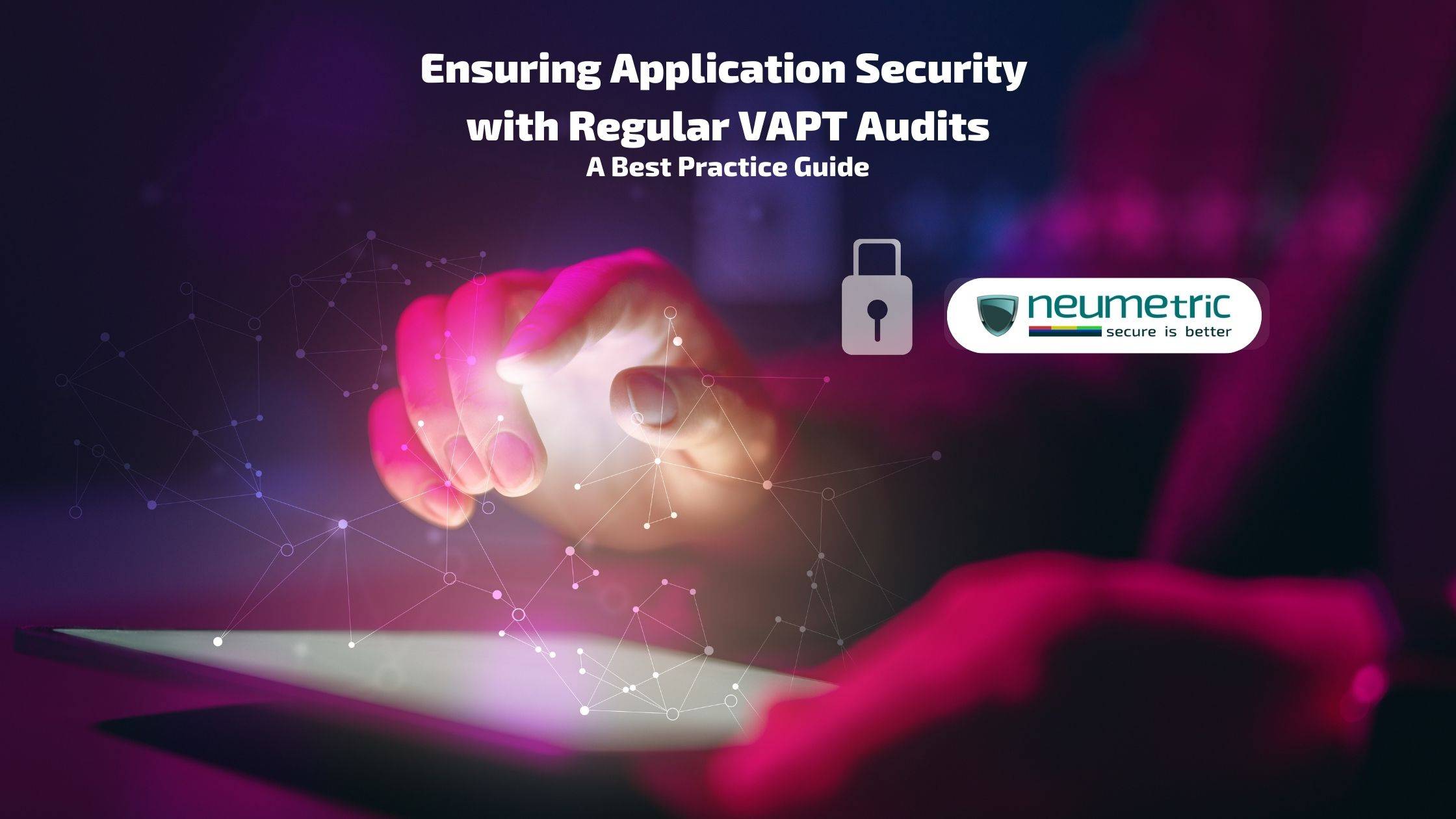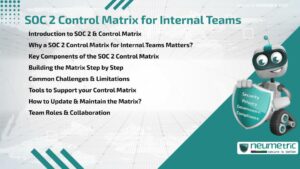Table of Contents
ToggleEnsuring Your Application Security with Regular VAPT Audits : A Best Practice Guide
Introduction
In today’s digital landscape, application security is of paramount importance. With the rapid advancements in technology & the increasing reliance on digital platforms, organisations must prioritise the protection of their applications to mitigate potential risks & safeguard sensitive data.
To ensure robust application security, organisations should consider conducting regular Vulnerability Assessment & Penetration Testing [VAPT] Audits. This comprehensive methodology evaluates the security of systems, networks & applications. It consists of two main components: Vulnerability Assessment [VA] & Penetration Testing [PT]. The assessment phase focuses on identifying vulnerabilities, while the testing phase involves actively exploiting them to simulate real-world attacks. VAPT provides organisations with a holistic view of their security posture, helping them identify weaknesses, assess risks & implement remediation measures.
Organisations should initially conduct thorough pre-audit preparations, which involve scoping the audit, defining objectives, documenting boundaries & setting up a representative test environment. Clear scoping ensures that critical areas of the application are adequately covered. Next, a comprehensive Vulnerability Assessment [VA] should be performed, utilising specialised tools & techniques to identify & assess vulnerabilities. This should be followed by Penetration Testing [PT], actively exploiting identified vulnerabilities to evaluate the application’s resilience. Finally, a detailed reporting & remediation process should be implemented to document findings & prioritise necessary fixes.
Understanding Application Security
Application security refers to the measures & practices implemented to protect software applications from potential threats & vulnerabilities. It involves a comprehensive approach to identify, prevent & mitigate security risks throughout the application’s lifecycle. Common vulnerabilities & threats to applications include injection attacks (such as SQL injection), Cross-Site Scripting [XSS], Cross-Site Request Forgery [CSRF], Weak Authentication & Session Management, Security Misconfigurations, Insecure Direct Object References [IDOR], Denial of Service [DoS] attacks & Unvalidated Input. These vulnerabilities can result in the execution of arbitrary code, data theft, unauthorised access & service disruption. Understanding & addressing these vulnerabilities are crucial for organisations to implement effective security measures & protect the integrity of their software systems.
Vulnerability Assessment & Penetration Testing [VAPT] Audits play a crucial role in mitigating application security risks. These audits help organisations identify vulnerabilities, assess potential risks & implement necessary measures to enhance the overall security posture of their applications. Here are key ways in which VAPT Audits checklist contribute to mitigating application security risks:
- Identifying Vulnerabilities: VAPT Audits checklist systematically scan applications, networks & systems to identify vulnerabilities, allowing organisations to proactively address weaknesses before they can be exploited.
- Assessing Risks: VAPT Audits go beyond identifying vulnerabilities & assess the associated risks, helping organisations prioritise security efforts & allocate resources effectively.
- Enhancing Security Controls: VAPT Audits checklist evaluate the effectiveness of existing security controls, allowing organisations to identify gaps & implement necessary improvements, thereby strengthening overall security infrastructure.
- Validating Security Measures: VAPT Audits validate the efficacy of security measures by actively exploiting vulnerabilities & assessing the resilience of applications against real-world attacks.
- Compliance & Regulatory Requirements: VAPT Audits help organisations meet compliance standards & regulatory requirements, demonstrating adherence to industry best practices & ensuring applications align with security regulations.
The Benefits of Regular VAPT Audits
The significance of application security lies in the following aspects:
- Protecting sensitive data: Application security ensures the confidentiality, integrity & availability of sensitive data, preventing unauthorised access or manipulation.
- Preventing cyber attacks: Robust app security measures like secure coding, vulnerability assessments & penetration testing address vulnerabilities, safeguarding against data breaches & hacking attempts. Application security measures such as secure coding, input validation & access controls mitigate the risk of various attacks, including injection attacks, cross-site scripting & authentication bypass.
- Ensuring regulatory compliance: Prioritising app security helps organisations comply with regulatory frameworks like GDPR, HIPAA & PCI DSS, protecting customer data & avoiding penalties.
- Safeguarding business reputation: Prioritising application security demonstrates a commitment to protecting customer data, preserving reputation & competitive advantage.
- Minimising financial losses: App security investments reduce the likelihood & impact of security incidents, minimising financial losses related to incident response, data recovery, legal actions & customer compensation.
- Ensuring business continuity: Robust app security measures prevent disruptions in critical systems & services, ensuring business operations continue smoothly, maintaining customer satisfaction & preventing financial losses.
Key Components of a Successful VAPT Audit
The key components of a successful VAPT Audit includes the following:
- Pre-audit preparations: Scope & define objectives, identify critical assets & set up a representative test environment for accurate vulnerability detection.
- Vulnerability Assessment: Use tools & techniques to scan, analyse configurations & code & assess network traffic to identify potential vulnerabilities comprehensively.
- Penetration Testing: Skilled testers actively exploit vulnerabilities, simulating real attacks to assess resilience & uncover any missed weaknesses.
- Reporting & Remediation: Document findings, including impact analysis, recommendations for fixes & prioritise & implement remediation measures. Continuous monitoring & periodic re-audits maintain application security.
Frequency & Timing of VAPT Audits
Determining the appropriate frequency of Vulnerability Assessment & Penetration Testing [VAPT] Audits is crucial to maintain effective application security. The frequency of these Audits should strike a balance between the evolving threat landscape, the criticality of the application & resource availability. Here are key factors to consider when determining the frequency of VAPT Audits:
- Application Lifecycle: Audit frequency depends on the stage of the application’s lifecycle & can be adjusted as it matures.
- Risk Profile: The risk profile of an application determines audit frequency, with high-risk applications requiring more frequent assessments.
- Compliance Requirements: Compliance standards dictate audit frequency, often annually, quarterly or more frequently.
- Changes in Infrastructure or Environment: Significant changes trigger audits to identify vulnerabilities introduced.
- Threat Landscape: Monitoring the evolving threat landscape helps assess the need for more frequent audits.
- Internal & External Factors: Internal considerations like resources & external factors like emerging threats influence audit frequency.
Conducting audits during the development lifecycle of an application is essential to ensure robust security measures are in place from the early stages. Here are key considerations for conducting audits during the development lifecycle:
- Early Integration of Security: Incorporate security into development early on to identify vulnerabilities & design flaws, saving time & costs.
- Secure Coding: Evaluate adherence to secure coding practices, including input validation & protection against common vulnerabilities.
- Threat Modelling & Risk Assessment: Assess potential threats, evaluate impact & prioritise security measures based on risk.
- Regular Security Testing: Conduct ongoing vulnerability assessments & penetration testing to identify & address vulnerabilities promptly.
- Collaboration & Communication: Foster collaboration between development, security & testing teams for effective security implementation.
- Compliance considerations: Assess compliance with security standards & regulatory obligations specific to the industry.
Periodic & post-upgrade audits play a crucial role in ensuring the ongoing security & integrity of applications. Here are key reasons highlighting the importance of conducting these audits:
- Detection of new vulnerabilities: Regular audits are essential to identify emerging vulnerabilities & stay ahead of potential security risks. Post-upgrade audits are crucial for evaluating vulnerabilities introduced during system upgrades.
- Compliance & Regulatory Requirements: Periodic security audits help organisations demonstrate compliance with industry standards & regulatory requirements. Post-upgrade audits validate compliance after system changes or upgrades.
- Verification of Security Controls: Audits assess the effectiveness of existing security controls, ensuring they function as intended & protect against threats. They identify gaps or weaknesses, enabling corrective actions.
- Prevention of Data Breaches & Attacks: Audits identify & address vulnerabilities to prevent data breaches & cyber attacks. Regular audits mitigate risks, enhance security & reduce unauthorised access.
- Continual Improvement: Audits provide insights for improving application security. They identify areas for enhancement, supporting continuous development of robust security practices.
- Assurance & Stakeholder Confidence: Audits demonstrate a commitment to high security standards, assuring stakeholders that risks are addressed. They build confidence among customers, partners & regulatory bodies.
Selecting the Right VAPT Service Provider
To select the right VAPT service providers, the following need to be considered:
- Evaluating expertise & experience: Assess certifications, industry recognition & track record to partner with skilled experts who meet your needs.
- Assessing methodologies & tools: Determine if the service provider uses industry-standard frameworks, cutting-edge technologies & extensive testing methodologies.
- Reviewing customer testimonials & case studies: Gain insights into service provider performance, reliability, professionalism & ability to deliver through feedback & real-life examples.
- Obtaining clear pricing & deliverables: Request a detailed breakdown of costs, understand the scope of services, set expectations for deliverables, timelines & additional fees or support. Clarity ensures transparency & minimises misunderstandings.
Neumetric, a cyber security services and products company, provides VAPT for kinds of assets such as Web Applications, Mobile Applications, Virtual Private Cloud [VPC] networks and APIs. Contact [email protected] to know more about the VAPT services and the methodologies we follow to secure your applications.
FAQs:
What is a VAPT Audit?
A Vulnerability Assessment & Penetration Testing [VAPT] Audit is a comprehensive security assessment conducted on an organisation’s network, systems & applications. It involves evaluating vulnerabilities, simulating real-world attacks & providing recommendations to enhance security.
What is the scope of VAPT Audit?
The scope of a VAPT Audit typically encompasses identifying security vulnerabilities, conducting penetration testing, assessing network configurations, analysing system architecture, evaluating access controls & reviewing security policies & procedures.
What is VAPT analysis?
VAPT analysis refers to the process of analysing the results obtained from a Vulnerability Assessment & Penetration Testing [VAPT] exercise. It involves examining vulnerabilities, exploits & potential risks to provide insights into the security posture of the assessed systems & recommend appropriate mitigation measures.
What is the compliance of a VAPT Audit?
The compliance of a VAPT Audit refers to the extent to which an organisation adheres to the recommended security practices & mitigates identified vulnerabilities. It involves implementing the necessary security controls, patching vulnerabilities, addressing weaknesses & ensuring that the systems meet the required security standards & regulations.





